 |
: July 2003 |
||||||||
| Discovery :
This whistle was found in the collection of a Parisian ceramics enthusiast. Its precise origin is unknown. General description: It is a zoomorphic whistle with a globular body. The whistle is inserted into its back. The body has a circular hole (D=0,5cm) at the back of the right aspect. It is entirely covered with a dark green lead glaze with lighter-coloured zones where the glaze has pooled,except for two glaze skips, one to the right of the base, the other on the left size of the body. |
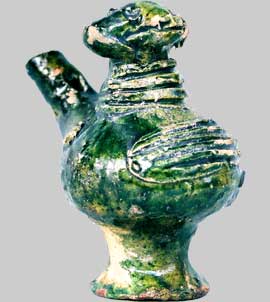
  |
||||||||
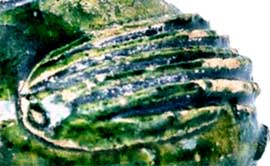 Detail of the decoration |
The decoration:
Two flattened clay pastilles were stuck on the whistle: one in front of the neck and the other in front of the body. Both are incised with horizontal indentations. The mouth is also marked by an incised line. The eyes are simply represented by dots made with a tool. |
||||||||
| Study of the object : Typology: Although blocked, it is no doubt a water whistle. The mouth piece opens outside the globular body at the middle of the whistle. The location of the circular hole corresponds to the filling holes of other water whistles.
|
|||||||||
| Glaze: The whistle has been presented as a Parisian ceramic of the 16th century but knowing the inaccuracy of ceramic dating, one must look carefully at this assertion. Indeed, the green glaze corresponds to the glaze used at times in the 16th century. The former parisian models had only green glaze spots. This type of glaze fits those used during a broad time span, from the 15 to the 17th century.
|
|||||||||
| Analyzise:
The type of decoration formed by flattened and striated pastilles is found on a well-known series in the Paris area: decorated "cuttlery baskets".
|
|||||||||
A visit to the national museum of the ceramics of Sevres confirms this statement. Among the whistles linked with a series of "cuttlery baskets", a whistle in the shape of bird is most similar in form to the studied whistle. The decorative style can be connected with a whistle in the shape of cock found in the village of Fosses at the time of excavations of the workshops of potters from the 16th century. This whistle has also many similarities with those whistles exhibited in the museum of Sevres. Only a comparative study of all aspects, in particular the analysis of clay, would make it possible to further this study. The presence of anthropomorphic whistles very similar to the "cuttlery baskets" results in wondering about the function of these objects. The water whistles reproduce either animals or jugs shapes. If it is considered that these anthropomorphic whistles were used at the time of hullabaloos, it is possible that these "cuttlery baskets" were jugs carried out for similar occasions what would explain their whimsical character. | .jpg) National museum of Sevres ceramics |
||||||||
It remains to determine the animal represented. The general shape of the head makes think of a sheep. The sheep represented often do not present hanging ears however of such races exist.
| 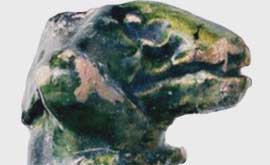 |
||||||||
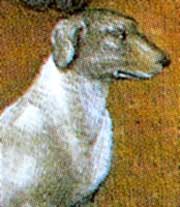 Glandée. Very rich hours of the Duke of Berry, detail 15th S . 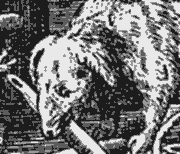 Fatty kitchen. Detail. Engraving according to Bruegel P. Van der Heyden, 16th century |
The sheep being unknown among the shapes of whistle in France, one can also think of a dog. One knows many whistles in the shape of dog as from the 17th century in all the North of France. Moreover, several contemporary representations of dog to the whistle show a race rather similar to the animal of the whistle.
One can conclude temporarily that it is about a water whistle of a workshop of the Paris area in form of a dog(?) 16th century (late 16th?) and undoubtedly intended to be a toy. Never used because it was blocked, it is probably about a failure of firing. A precise location of discovery would have given many informations.
|
||||||||